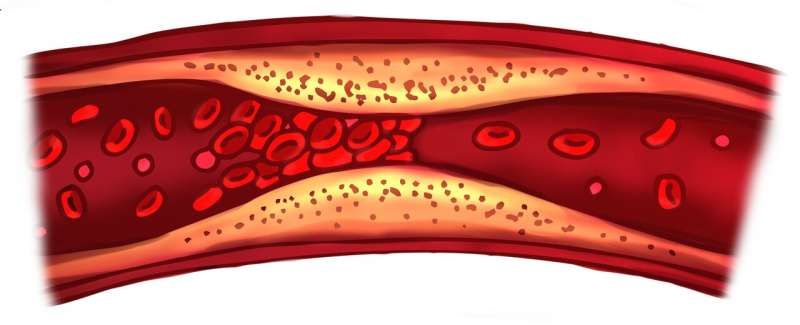This article has been reviewed according to Science X's editorial process and policies. Editors have highlighted the following attributes while ensuring the content's credibility:
fact-checked
trusted source
proofread
Large, real-world study compares modern treatment options for pulmonary embolism

A large, modern real-world analysis published today in the Journal of the Society for Cardiovascular Angiography & Interventions provides vital insights into the safety of novel therapies including ultrasound-assisted catheter-directed thrombolysis (USCDT) and mechanical thrombectomy (MT) that have been developed to address the increased morbidity and mortality of elevated risk pulmonary embolism (PE). Findings were presented today at TCT 2023.
Pulmonary embolism is a potentially life-threatening condition where a blood clot embolizes to the lungs, obstructing pulmonary blood flow. Traditionally, treatment options have included anticoagulant therapy, and in severe cases, surgical intervention. However, recent advancements in medical technology have introduced new minimally invasive procedures like ultrasound-assisted catheter-directed thrombolysis and mechanical thrombectomy.
Ultrasound-assisted catheter-directed thrombolysis is a procedure in which a catheter is threaded through the blood vessels to the site of the clot, and a thrombolytic drug is delivered directly into the thrombus. Ultrasound energy is applied during the infusion to assist in breaking down the clot and restoring blood flow. Mechanical thrombectomy involves using a device to physically remove the thrombus from the blood vessel.
In the REAL.PE study, all data from the Truveta, Inc. system were analyzed including 83,612,413 patients treated within 16 health care systems. This included analysis of 535,567 with PE. Every patient treated with USCDT (Boston Scientific) or MT (Inari Medical) for PE was identified. A primary analysis included every procedure performed within the system encompassing procedures performed from January 2009–May 2023.
A contemporary analysis was also performed on all procedures between January 2018–May 2023 to allow for focus on procedures performed using up-to-date techniques and proceduralist skills. Bleeding was assessed via direct laboratory analysis and transfusion administration documentation. ISTH and BARC 3b definitions were also modeled. Multiple logistic regression analysis of major bleeding was performed, and in-hospital death and median length of stay was measured.
The results of the study were informative and important. The increasing use of advanced endovascular therapies was demonstrated and ultrasound-assisted catheter-directed thrombolysis emerged as the preferred approach due to its lower risk of complications particularly major bleeding. This finding was demonstrated in both cohorts and by all measures.
An increased risk of intracranial hemorrhage with MT was also demonstrated in medical coding data documented within 7 days after the procedure. There were no statistically significant differences between the therapies in length of stay, readmission or inpatient mortality. The study also highlighted the importance of individual patient characteristics in determining the most suitable treatment modality.
For the primary analysis, 2,259 patients (N=1577 USCDT, N=682 MT) and for the contemporary analysis 1,798 patients (N=1,137 USCDT, N=661 MT) met criteria.
Incidence of hemoglobin reduction (>2 and >5 g/dL) and transfusions received were significantly higher among MT- treated patients in both analyses, as was ISTH and BARC3b major bleeding (primary: ISTH MT 17.3% vs. USCDT 12.4% p=0.002; BARC3b MT 15.4% vs. USCDT 11.8% p=0.019) (contemporary: ISTH MT 17.2% vs. USCDT 11.0% p =0.0002; BARC3B MT 15.4% vs. USCDT 10.6% p=0.002). Regression analysis demonstrated that MT is uniquely associated with major bleeding. Median LOS, all-cause 30-day readmission and in-hospital mortality were similar between groups. Intracranial hemorrhage was more common with MT.
"This study is a significant step forward in our understanding of the treatment options available for pulmonary embolism," said Peter Monteleone, MD, FSCAI, lead researcher of the study. "The use of real-world data analytics like those used in REAL.PE holds the potential to revolutionize the way we are studying device effectiveness and safety and can transform our practice and protect our patients."
More information: Peter Monteleone et al, Modern Treatment of Pulmonary Embolism (USCDT Versus MT): Results From a Real-World, Big Data Analysis (REAL-PE), Journal of the Society for Cardiovascular Angiography & Interventions (2023). DOI: 10.1016/j.jscai.2023.101192
Session Details: Real World Experience of Contemporary Pulmonary Embolism Treatment (USCDT versus MT): Insights From Big Data Analytics (REAL-PE) Peter P. Monteleone; Endovascular Spotlight 3: Featured Clinical Science With Live Case; Tuesday, October 24, 2023 12:15 PM PDT




















